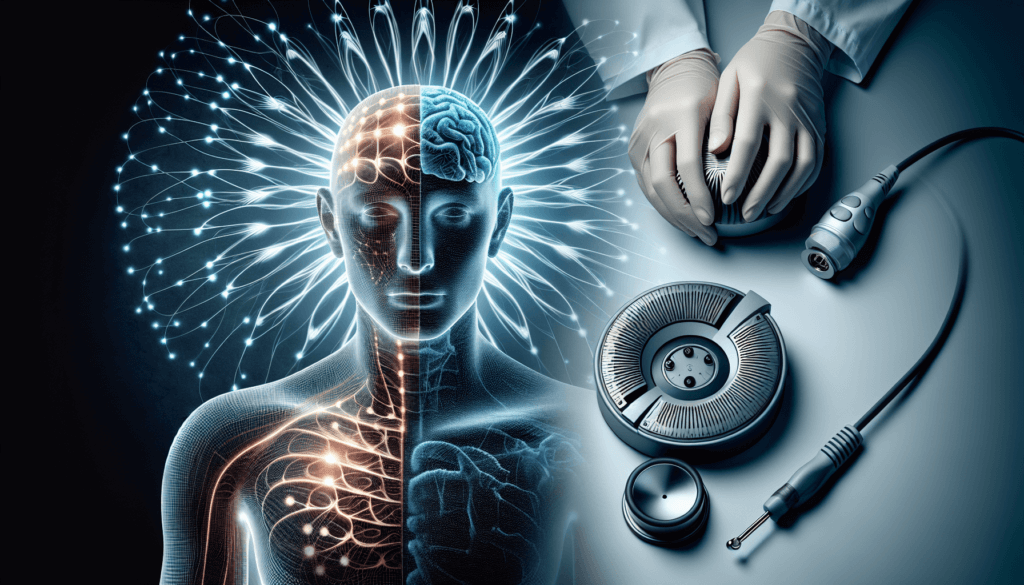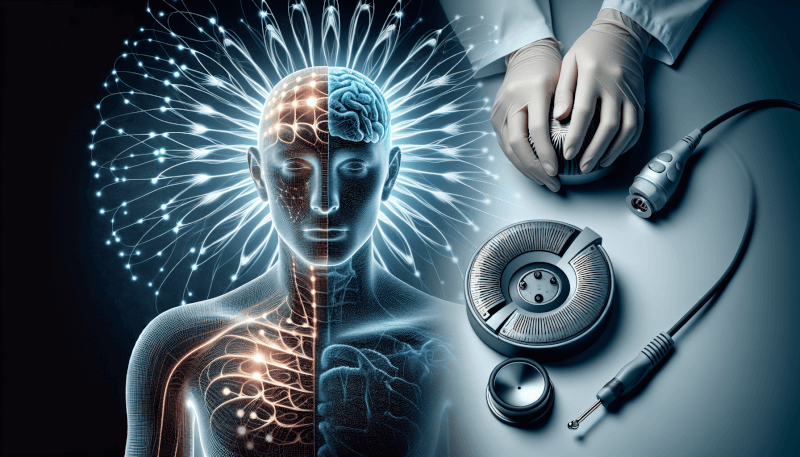Whether you’re seeking relief from pain or aiming to enhance your overall well-being, the choice between PEMF and Bemer can be a perplexing one. Both therapies claim to offer remarkable benefits, but how do they differ? In this article, we’ll explore the contrasting features of PEMF and Bemer, shedding light on their unique approaches and helping you make an informed decision. So, grab your cup of tea and join us as we unravel the world of Pemf Vs Bemer!
What is PEMF?
PEMF stands for Pulsed Electromagnetic Field therapy. It is a type of therapy that uses electromagnetic fields to improve overall health and wellbeing. The therapy involves the use of low-frequency electromagnetic waves that are applied to the body to stimulate cellular activity.
Definition
PEMF therapy works by exposing the body to electromagnetic fields that mimic the frequency and intensity of the Earth’s natural magnetic field. This helps to stimulate the body’s natural healing processes, improve blood flow, and promote pain relief.
How it works
PEMF therapy works on a cellular level by stimulating the body’s cells’ electromagnetic energy. The electromagnetic fields help to increase the electrical charge of cells, which in turn improves cellular metabolism and function. This improved cellular function can lead to a range of health benefits, including reduced inflammation and pain, enhanced tissue healing, increased energy levels, improved sleep, and overall improved physical and mental wellbeing.
Benefits of PEMF
There are several benefits associated with PEMF therapy. These include:
-
Pain relief: PEMF therapy has been found to effectively reduce pain in various conditions, including musculoskeletal disorders, arthritis, and fibromyalgia.
-
Improved healing: The electromagnetic fields used in PEMF therapy help to enhance tissue healing by improving blood flow and cell regeneration.
-
Increased energy levels: PEMF therapy has been shown to boost energy levels by promoting better cellular function and increasing ATP production.
-
Reduced inflammation: The anti-inflammatory effects of PEMF therapy can help reduce inflammation in the body, resulting in decreased pain and improved overall health.
-
Enhanced sleep: Many individuals who undergo PEMF therapy report improved sleep patterns and quality, leading to increased rest and rejuvenation.
What is Bemer?
Bemer is a form of therapy that also utilizes pulsed electromagnetic field technology. Bemer specifically focuses on improving microcirculation, which is the blood flow in the smallest blood vessels in the body. By enhancing microcirculation, Bemer aims to support the body’s natural healing processes.
Definition
Bemer therapy involves the use of a specialized Bemer device, which emits specific frequency patterns that target the body’s microcirculation. These frequency patterns are designed to enhance blood flow and oxygen delivery to cells, tissues, and organs, ultimately promoting overall health and wellbeing.
How it works
Bemer therapy works by emitting electromagnetic waves that stimulate the targeted microcirculation of the body. The Bemer device consists of a mat or pad that can be placed on different areas of the body, allowing for localized therapy. The electromagnetic waves generated by the Bemer device help to improve blood flow, increase oxygenation, and enhance the body’s natural healing processes.
Benefits of Bemer
Bemer therapy offers several potential benefits, including:
-
Improved microcirculation: Bemer therapy specifically targets microcirculation, leading to enhanced blood flow and oxygen delivery to cells. This increased microcirculation can result in improved overall health and wellbeing.
-
Enhanced recovery: Bemer therapy has been shown to accelerate recovery processes, such as post-exercise recovery and wound healing. By increasing circulation and oxygenation, Bemer promotes faster healing and tissue repair.
-
Immune system support: The improved microcirculation from Bemer therapy can help support the immune system, enhancing its ability to fight off infections and diseases.
-
Stress reduction: Bemer therapy has been reported to have a calming and stress-reducing effect on the body. By improving circulation and promoting relaxation, it can help alleviate symptoms of stress and promote a sense of wellbeing.
Health Conditions Treated
PEMF
PEMF therapy has been used to treat a wide range of health conditions and ailments. It is commonly used for:
-
Chronic pain: PEMF therapy has been shown to effectively reduce chronic pain, including pain from conditions such as osteoarthritis, rheumatoid arthritis, and fibromyalgia.
-
Bone and joint disorders: PEMF therapy has been used to aid in the healing of fractures, promote bone density, and alleviate symptoms of osteoporosis.
-
Sports injuries: Athletes often turn to PEMF therapy to accelerate the healing process of sports-related injuries, such as sprains, strains, and tendonitis.
-
Sleep disorders: PEMF therapy has been found to improve sleep quality and reduce insomnia symptoms in individuals with sleep disorders.
Bemer
Bemer therapy is also used to address a wide range of health conditions and can be beneficial for:
-
Cardiovascular health: Bemer therapy aims to improve blood flow and circulation, which can benefit individuals with cardiovascular conditions, such as high blood pressure and circulatory disorders.
-
Chronic diseases: Bemer therapy may help alleviate symptoms and support overall health in individuals with chronic diseases, such as diabetes, multiple sclerosis, and autoimmune disorders.
-
Wound healing: Bemer therapy has been shown to promote faster healing and tissue regeneration in individuals with wounds, ulcers, and surgical incisions.
-
General wellbeing: Bemer therapy can be used to support overall wellbeing by promoting relaxation, reducing stress, and improving energy levels.

Technology and Mechanism
PEMF
PEMF therapy utilizes electromagnetic fields generated by specialized devices. These devices emit low-frequency electromagnetic waves that penetrate the body and stimulate cellular activity. The technology behind PEMF therapy involves the use of coils or mats that generate electromagnetic fields. These fields can be adjusted to specific frequencies and intensities to target different areas of the body for healing and pain relief.
The mechanism of action in PEMF therapy is based on the principle that electromagnetic fields can interact with the body’s cells, stimulating the cellular energy and enhancing different physiological processes. The electromagnetic fields help to increase the electrical charge of cells, promoting better cellular metabolism and function. This, in turn, leads to a range of therapeutic effects, including reduced inflammation, improved blood flow, enhanced tissue healing, and pain relief.
Bemer
Bemer therapy operates on a similar principle to PEMF therapy but specifically focuses on improving microcirculation. The Bemer device emits specific frequency patterns that target the body’s microcirculation, which consists of the smallest blood vessels. The technology behind Bemer therapy involves a multi-dimensional signal structure that affects the entire body’s microcirculation system.
The Bemer device consists of a mat or pad that emits electromagnetic waves. When the body is exposed to these waves, they penetrate deep into the tissues, stimulating the microcirculation and enhancing blood flow. The enhanced blood flow results in improved oxygenation and nutrient delivery to cells, tissues, and organs, promoting overall health and supporting the body’s natural healing processes.
Effectiveness and Research
PEMF
PEMF therapy has been the subject of numerous scientific studies and research papers, examining its effectiveness for various health conditions. Research has shown promising results for the following conditions:
-
Pain relief: Multiple studies have demonstrated the pain-relieving effects of PEMF therapy, particularly in conditions such as osteoarthritis, fibromyalgia, and musculoskeletal pain.
-
Bone healing: Studies have shown that PEMF therapy can accelerate the healing process of fractures and promote bone density in individuals with osteoporosis.
-
Wound healing: PEMF therapy has been found to improve wound healing, especially in chronic or non-healing wounds such as diabetic ulcers.
-
Sleep disorders: Research suggests that PEMF therapy can improve sleep quality and reduce insomnia symptoms in individuals with sleep disorders.
While more research is needed to fully understand the mechanisms and effectiveness of PEMF therapy, the existing studies indicate its potential as a non-invasive, drug-free treatment option for various health conditions.
Bemer
Bemer therapy has also been the subject of scientific research and clinical studies. Some key findings include:
-
Microcirculation improvement: Research shows that Bemer therapy significantly improves microcirculation in various tissues, including the brain, muscles, and skin.
-
Enhanced blood flow: Studies have demonstrated Bemer therapy’s ability to increase blood flow, oxygenation, and nutrient delivery to cells, tissues, and organs.
-
Sports performance and recovery: Research suggests that Bemer therapy can enhance sports performance and aid in post-exercise recovery, improving muscle regeneration and reducing fatigue.
-
Diabetes management: Bemer therapy has shown promise in improving blood circulation and glycemic control in individuals with diabetes.
While further research is needed to explore Bemer therapy’s full potential, the existing studies indicate its positive effects on microcirculation and overall wellbeing.
Safety and Side Effects
PEMF
PEMF therapy is generally considered safe when used as directed. The electromagnetic fields used in PEMF therapy are low-frequency and non-ionizing, meaning they do not have the same harmful effects as high-frequency ionizing radiation, such as X-rays or nuclear radiation.
Although rare, some individuals may experience mild side effects from PEMF therapy, such as skin irritation or temporary discomfort during or after the session. However, these side effects are usually minimal and temporary.
It is important to note that PEMF therapy may not be suitable for individuals with certain medical conditions, such as pregnancy, epilepsy, pacemakers, or implanted devices. It is always recommended to consult with a healthcare professional before starting PEMF therapy.
Bemer
Bemer therapy is also considered safe and non-invasive when used as directed. The low-frequency electromagnetic fields emitted by the Bemer device have been tested and proven safe for human use.
Similar to PEMF therapy, mild side effects such as temporary skin irritation or discomfort may occur in some individuals, but these effects are typically minimal and temporary.
As with any therapy, it is important to consult with a healthcare professional before using Bemer therapy, especially if you have any underlying medical conditions or are pregnant.
User Reviews and Testimonials
PEMF
User reviews and testimonials for PEMF therapy are generally positive, with many individuals reporting significant pain relief, improved sleep quality, increased energy levels, and overall improved wellbeing. Users have frequently noted the non-invasiveness and lack of side effects as particular benefits of PEMF therapy.
However, it is important to note that individual experiences may vary, and PEMF therapy may not work as effectively for everyone. It is always recommended to consult with a healthcare professional to determine if PEMF therapy is suitable for your specific needs.
Bemer
Bemer therapy has also garnered positive user reviews and testimonials. Many individuals have reported improvements in microcirculation, reduced pain, enhanced recovery, and overall increased energy levels. Users have also highlighted the device’s ease of use and convenience.
As with any therapy, results may vary from person to person. It is essential to consult with a healthcare professional to determine if Bemer therapy is appropriate for your individual circumstances.
Cost and Accessibility
PEMF
The cost of PEMF therapy can vary depending on several factors, including the location, specific device used, and the duration of treatment. Some individuals may choose to invest in a personal PEMF device for home use, while others may opt for sessions at specialized clinics. Cost ranges from a few hundred to several thousand dollars, depending on the options chosen.
Accessibility of PEMF therapy is increasing as the technology becomes more widely recognized. It is available at specialized clinics, wellness centers, and even some spas. Personal PEMF devices for home use can also be purchased online, making it a more accessible option for long-term use.
Bemer
The cost of Bemer therapy is also variable, depending on factors such as location, duration of treatment, and whether one chooses to purchase a personal Bemer device or opt for clinic sessions. Costs can range from a few hundred to several thousand dollars.
In terms of accessibility, Bemer therapy is also becoming more widely available. Bemer devices can be purchased for personal use, and sessions can be found at specialized clinics and wellness centers.
Availability of Devices
PEMF
There are several PEMF device options available on the market, ranging from small, portable devices for personal use to larger, more advanced machines used in clinics. Some popular brands include Oska Pulse, Pulse Centers, and EarthPulse.
When choosing a PEMF device, it is important to consider factors such as the specific health condition or symptom being addressed, the desired frequency and intensity settings, and personal preferences for device size and portability. Consulting with a healthcare professional or PEMF specialist can be helpful in determining the most suitable device for individual needs.
Bemer
Bemer therapy is primarily delivered through the use of Bemer devices. These devices come in various forms, including mats, pads, and stand-alone units. Bemer devices are available for purchase, allowing individuals to use them in the comfort of their own homes. The Bemer company provides authorized distributors who can help guide individuals in selecting the most appropriate device for their needs.
Access to Bemer devices is expanding as the therapy gains recognition and popularity. Bemer sessions can also be found at specialized clinics and wellness centers, providing another option for those interested in experiencing the therapy.
Conclusion
Comparing PEMF and Bemer
Both PEMF and Bemer therapies offer unique approaches to improving health and wellbeing using pulsed electromagnetic field technology. While they share similarities in terms of stimulating cellular activity and promoting overall wellness, they have different focuses.
PEMF therapy is more versatile in terms of addressing a wide range of health conditions, including chronic pain, bone healing, and sleep disorders. It provides overall systemic benefits through improved blood flow, cellular function, and reduced inflammation.
Bemer therapy, on the other hand, specifically targets microcirculation and offers potential benefits for cardiovascular health, wound healing, and general wellbeing. It focuses on enhancing blood flow and oxygen delivery to cells, tissues, and organs, supporting the body’s natural healing processes.
Choosing the right option
Choosing between PEMF and Bemer therapy depends on individual needs, preferences, and specific health conditions. It is advisable to consult with a healthcare professional or therapy specialist who can provide personalized recommendations based on your unique circumstances.
Factors to consider include the desired therapeutic effects, the accessibility and cost of each therapy, and the ease of use and availability of devices. Additionally, reading user reviews and testimonials can provide insights into others’ experiences with the therapies.
Ultimately, both PEMF and Bemer offer potential benefits for improving health and wellbeing. Exploring and understanding these therapies can empower individuals to make informed decisions in their pursuit of optimal health.


